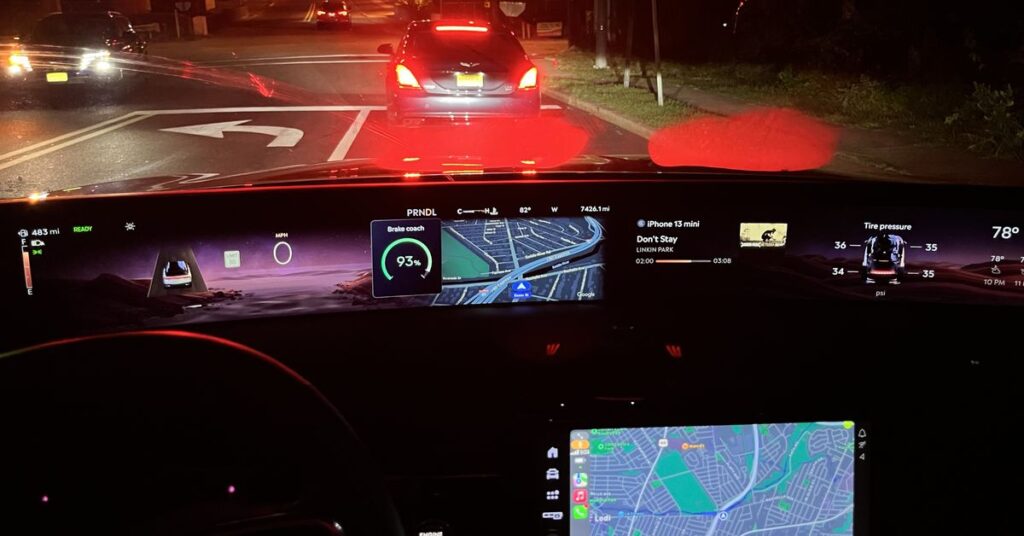As I drove down the highway in the 2024 Lincoln Nautilus, a hybrid SUV from Ford’s luxury brand, I saw a double vision. I have Apple Maps running on my center touch screen, projected from my iPhone via Apple CarPlay. I also saw the same map mirrored above, taking up about a quarter of the massive display that takes up the length of the dashboard.
The screen is a 48-inch panoramic display that runs Android Automotive OS, Google’s native vehicle platform (not to be confused with phones that cast Android Auto). It blends what is actually two pieces of curved glass in a mesmerizing, cinematic style, uniting the dashboard with the infotainment system and a few widgets. On the Nautilus, the entire system is called the “Lincoln Digital Experience.”
But as with most modern cars, formerly physical controls are being sucked into the digital world of screens. To adjust the airflow, I had to do something many drivers wouldn’t dare do: switch from CarPlay navigation to the car’s native interface. But to my delight, Apple Maps continues to run on the full-view display above, as Lincoln’s on-screen draggable digital airflow controls take over the 11.1-inch center display.
Much to my delight, Apple Maps continues to work on the Panorama display
I’m starting to understand. Most cars take an either/or approach to native vs. projected operating systems. A few vehicles, such as the Polestar 2, can also project Apple Maps onto the dashboard screen. But Lincoln’s larger, uncrowded surround view display takes the experience to the next level.
Today, some automakers are in a tug-of-war with Apple and Google because drivers love their phones and prefer the interface of their mobile devices to the one provided at the factory. Some manufacturers have made the controversial decision to either discontinue phone projection (GM) or not add it in the first place (Rivian and Tesla). But Ford takes a different position: It thinks it can do both.
For the sake of the company’s credibility, I think it works. Ford is embracing customer choice, and the new Nautilus offers what I think is the best balance of phone mirroring and built-in software we’ve ever seen.
Three years in the making
Ford has spent years developing new infotainment systems, searching for the best software supplier, taking the company from Microsoft to BlackBerry and now to Google. Ford and Google reached a six-year agreement in 2021 to bring Android Automotive to “millions” of cars, and the Lincoln Nautilus is the first car to reflect the results of the agreement.
The partnership means Ford will use Google as its cloud provider for connected car services, promising features such as Google Assistant voice control for changing climate settings, car-approved Android apps and over-the-air software updates.
Android gives Ford “an opportunity to really have a stable platform”
during an interview decoderFord Chief Executive Jim Farley said he just wants his team to develop better navigation software than what’s available on smartphones. “Android or Google Auto services give us the opportunity to really have a stable platform,” Farley said.
Ford is now rolling out a new Android-based “digital experience” across its vehicle lineup. The company’s strategy is to invest more in screens in the luxury segment and trim specs in vehicles like the 2025 Explorer, while balancing its still-supported but relatively slow QNX-based Sync 4 system, like the one in the 2024 Maverick .
A computer on wheels is a smartphone
Overall, Lincoln’s digital experience gives me confidence that the automaker can finally deliver an infotainment system that’s both capable and intuitive. That said, I’m still connected to my iPhone. After all, that’s the point.
I can seamlessly transition from Google Maps on the center screen and panoramic screen to Apple Maps via CarPlay. I got in and out of the vehicle multiple times, and most of the time, everything connected instantly, save for some limited center screen blackout lag, especially when connecting wirelessly. I’ve had similar success casting from my Google Pixel 8 Pro to Nautilus via Android Auto. It’s kind of interesting to see Google Maps and Assistant replace Google Maps and Assistant.
My expectations for in-car software are generally low. But the Nautilus feels more like a powerful, high-end Android device, and it even has a Google Play Store app. The usual suspects like Spotify and YouTube were already pre-installed, and I tried a program called Nitro pitch 2it performed well on the touch screen as I swiped the autonomous car in different directions. (I haven’t tried playing with a Bluetooth game controller, but it’s supported.)
Games and streaming apps can only run when parked, and in the Nautilus it works on the center touch screen but not on the panoramic display. Lincoln has added a new “panorama mode” to the 2025 Navigator, which allows games and videos to run on both sides of the large screen, but this feature is not available in the Nautilus. Not all Google Play Store apps are there; I couldn’t download Netflix during my test, but I was able to use Amazon’s Prime Video and watch some Shah Rukh Khan Bollywood classics. (I forgot to log out, so enjoy the free movie, Lincoln.)
I played some music from the Sirius XM radio and my phone, and the 28-speaker Revel Ultima 3D audio system sounded great. A music widget to the right of the panoramic display shows album art, and you can control your music using the nifty trackpad on the steering wheel (although sometimes your thumb can slide around and select the wrong item on the screen grid, a bit like on the Apple TV remote slide on the device).
There’s also Google Assistant, which can accept voice commands to change car settings like interior temperature, but for some reason can’t accept simple navigation requests. Lincoln communications manager Anika Salceda-Wycoco later told me that this was a mistake on their part because they were using the same Google account on multiple cars in the fleet and had disabled the feature.
Tesla lets you type while driving, but not Ford
Regardless, voice will be your only option for changing destinations on the move, since the on-screen keyboard won’t pop up unless you park. Annoyed, I pulled over and manually entered the address of my second destination on this trip. I’m used to the Tesla Model 3 interface where my wife can enter addresses for me on the screen while driving, but that’s not possible on the Nautilus. Siri worked well in CarPlay mode, but I couldn’t ask it to do things like turn on the air-conditioned seats.
2024 is all about technology most of the time
But not all is well between Lincoln and smartphone interfaces. They do occasionally snap at each other on screen. For example, calling Google Assistant while CarPlay is running creates an ugly transition to the built-in Lincoln interface. The same goes for when you’re in the Lincoln interface and suddenly jump back into CarPlay when you get a text message. The good thing is I can switch from CarPlay to Android Auto wirelessly. Quickly entering Bluetooth settings allowed me to switch between the iPhone 13 Mini and Pixel 8 Pro with ease, something I’ve never experienced with other vehicles.
Tesla’s Autopilot flashes a blue screen when you’re not paying attention, and launching BlueCruise is a bit surprising. When I swiped my thumb across the trackpad to the left of the steering wheel and selected the corresponding box for BlueCruise on the screen grid, the Lincoln’s dashboard turned completely blue – noticeably out of sync with the tranquil theme elsewhere on the surround-view display.
However, the menus on the Lincoln’s touchscreen operate with ease, the animations run gorgeously in Epic’s Unreal Engine, and the power of its powerful processor is clearly on par with some gaming Android phones.
Even with all its processing power, the Lincoln doesn’t do much. You don’t get a super-detailed interactive 3D model of the Nautilus that you can spin around like Tesla’s Cybertruck, or a colorful illustration of the interior of the Rivian. But you get a tasteful and quick transition, a cool 3D swoosh animation in the passenger seat showing who’s not buckling up, and a futuristic PS5 Halo theme on the panoramic display.
To my surprise, the huge panoramic display isn’t too information-heavy, and I never had to worry about the fuel bar, speedometer, transmission mode, or remaining range (of which, by the way, there’s usually quite a bit of it–the Nautilus was in The tank traveled nearly 500 miles). Lincoln placed the display high enough that I found it less distracting than some heads-up displays I’ve seen. But for some reason, when you speed up, a mana bar that looks like a wave increases horizontally, and it almost feels like a speed-up challenge.
Beyond the screen
The real reason anyone should pay attention to the Nautilus is the stunning panoramic display. The future of cars is definitely all about software, and Ford seems to be doing a good thing by striking the sweet spot between in-car infotainment systems and the popular phone-based systems that most people prefer. I was almost convinced when I opened the door and it introduced me to the full Nautilus intro animation on the panoramic monitor, with a wave animation moving to the sides and streaks of light appearing on the door in time.
Screens work great, but not everyone wants them. Surveys show growing customer dissatisfaction with in-car technology, especially touch-screen software. People are overwhelmed, and Ford’s response seems to be to add more screens, but that doesn’t guarantee success. I personally own a 2014 Lincoln MKZ Hybrid and consider myself tech-savvy. However, long-time Lincoln fans who prefer more physical controls (or at least dedicated touch buttons) on the previous generation model may find the digital experience too overwhelming for their tastes.
But if that’s not the case, and Lincoln customers are obsessed with the new screens, Ford may stumble upon the right formula to make it, Apple, and Google equal winners in the race to control the in-car experience.

